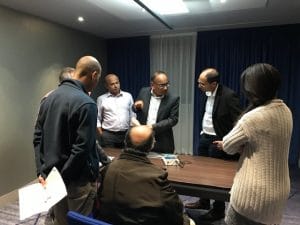
A marathon is meant to push people to their limits. It’s a challenge for even the most experienced athletes.
The whole idea of any training is that you push your body to the limits of what it can currently cope with and just slightly beyond.
When you train, you are putting stress on your body, causing mild trauma to your muscles and bones. As your muscles work and your bones absorb impact from your feet hitting the ground, your tissues break down a bit. During the time between workouts, those small tears and bone stress repair themselves. Over time, you gain strength and endurance, and your bones and muscles become stronger in the areas where they were weak; allowing you to deal with more stress the next time you train, therefore allowing you to push yourself slightly more as your training progresses.
The problem comes when you don’t allow adequate recovery time for your body to go through that adaptive process. It is important to maintain a state of balance between workload and recovery, which can help you prevent injury as you build endurance; stress after stress after stress with no recovery eventually equals injury. Your body can only cope with so much repeated stress before it starts to be unable to cope with it and something eventually gives. These types of injuries are known as overuse injuries. These running injuries usually affect bones, muscles or tendons. The most common areas to be affected are the knees, hips and feet and ankles.
More recent training programmes have encouraged a higher frequency of rest days and this is your biggest weapon in terms of reducing your risk of injury. Be sensible, listen to your body. If you allow it adequate rest and recovery then you will be at a much lower risk of injury than if you don’t. You need to cover the miles but not to the detriment of your health.
Other aspects that can significantly affect your recovery rate are hydration, sleep and nutrition.
What can be done to avoid injury?
Build strength
Muscle weakness and imbalance are one of the main causes of overuse injuries. Imbalances happen when one muscle group is too weak to do its job, causing nearby muscles to take over and help out. The more this happens, the greater the imbalance becomes. Some of the most common weak areas in runners are the hips, glutes and core. Strength training is a crucial part of endurance training. It improves tissue and muscle tolerance while improving endurance and performance, by reducing the energy required for each running stride. Engaging in a regular strength training program, that targets the lower limb muscles and core, will significantly help prevent imbalances and injury.
Wear comfortable and well-fitting shoes
Having comfortable shoes is vital when you are running long miles in them. Running in ill-fitting, uncomfortable or too-old shoes can lead to injuries, even if you have great running form and lots of experience. Use the various foot type categories as a rough guide, but comfort is the key.
It is really useful to get a proper fitting from a specialised running store, as they will often have treadmills and trained staff who can help guide you on the best trainers for you.
Don’t wait for knee or ankle pain to remind you it’s time for new running shoes; keep track of your training mileage on an app or on paper and replace your running shoes regularly; after 300 miles is the guide.
If you’re having foot problems when training, then it may be worth speaking to one of our orthopaedic foot experts. Not only could they solve any issues you’re having, they may well be able to provide helpful advice to ensure you’re able to tackle the course with ease.
Ramp things up gradually
It’s important to increase your mileage gradually. Adding too much too soon can overstress both the muscles and the bones. Work on increasing the time and frequency before worrying about intensity. A good guideline is to increase your running time or mileage by no more than 10% per week, but don’t feel you have to raise your mileage every week. Listen to your body.
Structure your training using the ‘hard-easy rule’, which means following your most challenging runs with either rest days or easy runs, so they are spaced out throughout the week. You can find training plans online that are tailored to the type of runner you are, whether you are beginner or more advanced. Keep in mind that most plans are 20-24 weeks in length with scheduled runs, cross training or strength workouts planned through the week.
Also, consider signing up for a half-marathon before going for the full.
Check your running technique
No one ever teaches us how to run – we just put one foot in front of the other and assume we’re doing it right. But there’s a growing interest in running technique or ‘form’ and a belief that good form can not only enhance performance but reduce the risk of injury.
Visualise yourself running tall, with an upright posture, rather than slouching your shoulders and sinking down. Try to stay relaxed and fluid.
Keep your rhythm (cadence) fast and use your arm swing to help keep your pace. Try not to land too heavily and keep your feet light.
I do a mental ‘body check’ every few miles, to assess your technique – “Are my shoulders hunched? Has my stride become a shuffle? Am I landing too heavily? Has my pace significantly slowed?” Your technique will deteriorate as you tire, so regular ‘check-ins’ with your body will help you maintain awareness and make any necessary adjustments.
There are a number of physiotherapists who London Bridge Orthopaedics work closely with, who offer specialised running clinics, where your technique can be assessed. This analysis is an assessment of a runner’s biomechanical movement and uncovers how efficiently you are moving. Everything from where you land on your foot, to your knee placement, to your posture is examined. The assessment has been proven to increase efficiency and decrease chance of injury by correcting poor form.
This type of evaluation can be beneficial for both novice and veteran runners and is appropriate for any distance. We would recommend anyone with an injury (old or new), get checked out before embarking on your training programme.
Mix up your training
Not every session you do in your marathon build-up has to be running. Include some cross-training, such as cycling, rowing or gym training, especially if you’re a running newbie or injury prone.
Make your cross-training sessions count so that you are still achieving a high volume of training without overdoing things.
For example, you could replace a long run with a long bike ride, a recovery run with a swim or an interval session with a workout on the step machine or cross trainer. Not only can cross-training limit your risk of injury, but it also makes training fun by keeping the body stimulated and ready to improve.
Get in plenty of Zzzzz
You may think of recovery as resting (or taking a day off from training), but your body needs more than that to rebuild muscle, remodel bone and recharge your mental energy stores. It also requires good nutrition and proper sleep. Sleep is when your body and brain do much of their recovery; you should aim for at least seven hours of sleep per night.
If you’re experiencing any symptoms from running, then please get in touch with us, and book an appointment to see one of our top, private orthopaedic specialists. For new patient bookings please call 0203 576 5296
For more orthopaedic advice and help, follow London Bridge Orthopaedics on Twitter, Facebook and LinkedIn.









